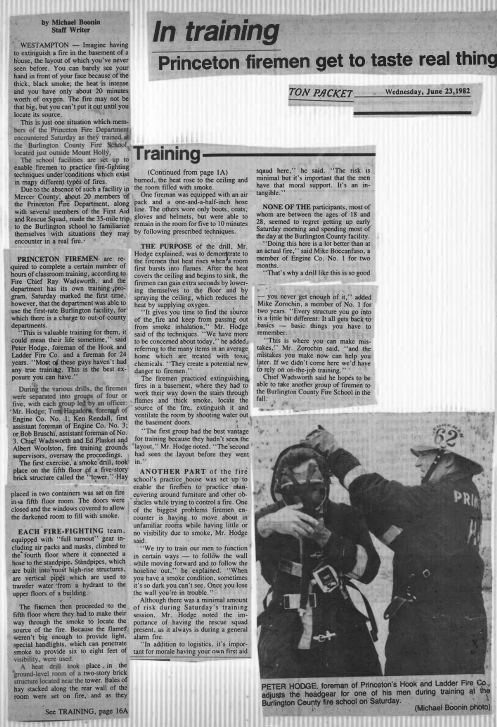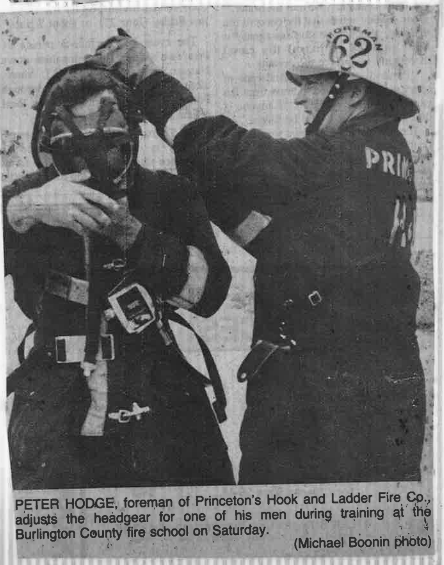
Princeton Packet
23 June 1982
In training:
Princeton firemen get to taste real thing
by Michael Boonin
Staff Writer
WESTAMPTON — Imagine having to extinguish a fire in the basement of a house, the layout of which you’ve never seen before. You can barely see your hand in front of your face because of the thick, black smoke; the heat is intense and you have only about 20 minutes worth of oxygen. The fire may not be that big. but you can’t put it out until you locate its source.
This is just one situation which members of the Princeton Fire Department encountered Saturday as they trained at the Burlington County Fire School, located just outside Mount Holly.
The school facilities are set up to enable firemen to practice fire-fighting techniques under conditions which exist in many different types of fires.
Due to the absence of such a facility in Mercer County, about 20 members of the Princeton Fire Department, along with several members of the Firs Aid and Rescue Squad, made the 35-mile trip to the Burlington school to familiarize themselves with situations they may encounter in a real fire.
PRINCETON FIREMEN arc required to complete a certain number of hours of classroom training, according to Fire Chief Ray Wadsworth, and the department has its own training program. Saturday marked the first time however, that the department was able to use the first-rate Burlington facility, for which there is a charge to out-of-county departments.
“This is valuable training for them, it could mean their life sometime.” said Peter Hodge, foreman of the Hook and Ladder Fire Co. and a fireman for 24 years. “Most of these guys haven’t had any true training. This is the best exposure you can have.”
During the various drills, the firemen were separated into groups of four or five, with each group led by an officer: Mr. Hodge; Tom Hagadom, foreman of Engine Co. No. 1; Ken Rendall first assistant foreman of Engine Co. No.3. or Bob Bruschi, assistant foreman of No. 3. Chief Wadsworth and Ed Plaskct and Albert Woolston, fire training grounds supervisors, oversaw the proceedings.
The first exercise, a smoke drill, took place on the fifth floor pf a five-story brick structure called the tower. Hay placed in two containers was set on fire in a fifth floor room. The doors were closed and the windows covered to allow the darkened room to fill with smoke.
EACH FIRE-FIGHTING team, equipped with “full turnout” gear including air packs and masks, climbed to the fourth floor where it connected a hose to the standpipe. Standpipes, which are built into most high-rise structures are vertical pipes which are used to transfer water from a hydrant to the upper floors of a building.
The firemen then proceeded to the fifth floor where they had to make their way through the smoke to locate the source of the fire. Because the flames weren’t big enough to provide light, special hand-lights, which can penetrate smoke to provide six to eight feet of visibility, were used.
A heat drill took place, in the ground-level room of a two-story brick structure located near the tower. Bales of hay stacked along the rear wall of the room were set on fire, and as they
See TRAINING, page 16A
Training
(Continued from page 1A)
burned, the heat rose to the ceiling and the room filled with smoke.
One fireman was equipped with an air pack and a one-and-a-half-inch hose line. The others wore only boots, coats, gloves and helmets, but were able to remain in the room for five to 10 minutes by following prescribed techniques.
THE PURPOSE of the drill. Mr. Hodge explained, was to demonstrate to the firemen that heat rises when a room first bursts into flames. After the heat covers the ceiling and begins to sink, the firemen can gain extra seconds by lowering themselves to the floor and by spraying the ceiling, which reduces the heat by supplying oxygen.
“It gives you time to find the source of the,fire and keep from passing out from smoke inhalation.” Mr. Hodge said of the techniques. “We have more to be concerned about today,” he added, referring to the many items in an average home which arc treated with toxic chemicals. “They create a potential new danger to firemen.”
The firemen practiced extinguishing fires in a basement, where they had to work their way down the stairs through flames and thick smoke, locate the source of the fire, extinguish it and ventilate the room by shooting water out the basement doors.
“The first group had the best vantage for training because they hadn’t seen the layout,” Mr. Hodge noted. “The second had seen the layout before they went in.”
ANOTHER PART of the fire school’s practice house was set up to enable the firemen to practice maneuvering around furniture and other obstacles while trying to control a fire. One of the biggest problems firemen encounter is having to move about in unfamiliar rooms while having little or no visibility due to smoke, Mr. Hodge said.
“We try to train our men to function in certain ways — to follow the wall while moving forward and to follow the hoseline out,” he explained. “When you have a smoke condition, sometimes it’s so dark you can’t see. Once you lose the wall you’re in trouble.”
Although there was a minimal amount of risk during Saturday’s training session, Mr. Hodge noted the importance of having the rescue squad present, as it always is during a general alarm fire.
“In addition to logistics, it’s important for morale having your own first aid sqaud here.” he said. “The risk is minimal but it’s important that the men have that moral support. It’s an intangible.”
NONE OF THE participants, most of whom are between the ages of 18 and 28. seemed to regret getting up early Saturday morning and spending most of the day at the Burlington County facility.
“Doing this here is a lot better than at an actual fire.” said Mike Boccanfuso. a member of Engine Co. No. 1 for two months.
“That’s why a dnll like this is so good— you never get enough of it.” added Mike Zorochin, a member of No. 1 for two years. “Every structure you go into is a little bit different. It all gets back to basics — basic things you have to remember.
“This is where you can make mistakes.” Mr. Zorochin said, “and the mistakes you make now can help you later. If we didn’t come here we’d have to rely on on-the-job training.”
Chief Wadsworth said he hopes to be able to take another group of firemen to the Burlington County Fire School in the fall.

Photo Caption:
PETER HODGE, foreman of Princeton’s Hook and Ladder Fire Co., adjusts the headgear for one of his men during training at Burlington County fire school on Saturday.
(Michael Boonin photo)